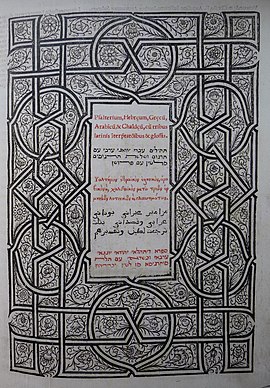Psalter (text book)
A psalter (Greek ψαλτήριον , Psalterion , Latin Psalterium ) is a liturgical book in the Orthodox and Catholic Churches that contains the biblical psalms , sometimes with additional texts. In the Jewish liturgy, the book of Psalms is referred to as (Sefer) Tehilim (סֵפֶר תְּהִלִּים).
Some illustrated psalter manuscripts have survived from the Middle Ages.
Different shapes
There are different forms of psalteries
- The psalms in the biblical order. This is the shape of most historical psalteries. In the Catholic tradition this is called Psalterium non feriatum .
- The psalms are divided according to the liturgical division of the Liturgy of the Hours . Referred to as Psalterium feriatum in the Catholic Church .
- In some psalters there are additional texts inserted ( antiphons , hymns )
Most psalms also contain a calendar with the feasts of the saints and prefaces to the psalms.
history
Hebrew version
The oldest surviving manuscript with a collection of biblical psalms in Hebrew is the Great Psalms Scroll (11Q5 / 11QPs a ) from Qumran from around the 1st century BC. The psalms are arranged in a different order and supplemented with further texts.
The first complete collection of the 150 psalms in Hebrew is contained in the Codex Leningradensis from 1008, the first complete Hebrew Bible manuscript at all.
Greek version
The first complete collection of the Psalms in Greek (Septuagint) is contained in the Codex Vaticanus from the 4th century. Separate psalteries have been preserved since the 6th century ( Verona Psalter ). These usually contain a collection of 14 odes from other books in the Bible. All Greek psalteries also contain a psalm 151 .
Syrian version
The Syrian psalm collections also contain Psalm 151 and four other Psalms .
Latin versions
The old Latin psalm translations are divided into three text versions:
- Psalterium Gallicanum ("Gallic Psalter"): Old Latin Vetus Latina translation based on the Greek text of the Septuagint, initially in the liturgy of the Merovingian Empire (Gaul), then generally used.
- Psalterium Romanum ("Roman Psalter"): Old Latin translation based on the Greek Septuagint, in liturgical use in Rome and Italy.
- Psalterium Hebraicum ("Hebrew Psalter"): Vulgate translation from the Hebrew text by Hieronymus , used for scholarly purposes, not in the liturgy.
Latin psalm translations of the 20th century are:
- Psalterium Pianum , commissioned by Pope Pius XII. Translated from the original text into Latin by the Pontifical Biblical Institute , published in 1945 and then included in the liturgical books.
- Psaltery of the Nova Vulgate , 1969/71 at the instigation of Pope Paul VI. Revised new version of the original texts, published in 1979 and incorporated into the Latin liturgical books.
Persian version
In the 6./7. Century from the Syrian text in China.
Church Slavonic version
Translated from the Greek text in the 9th century in Moravia, probably by Kyrill, Method and his students. Oldest manuscripts from the 11th / 12th centuries Century.
meaning
In the Middle Ages, the psalter was of great importance in everyday religious life, as a devotional exercise with daily recitation of psalms outside of the service was common, both among the clergy and among the laity.
Many psalteries were not only made for clergymen, but also as magnificently illuminated manuscripts for nobles. From the later 13th century the psalter was gradually replaced by the book of hours .
Major psalter
- Psalter of al-Mudil (late 4th or early 5th century, Coptic)
- Codex Veronensis (6th century, Greek)
- Codex Turicensis (7th century, Greek)
- Psalter of Montpellier (8th century)
- Vespasian Psalter (2nd half of the 8th century)
- Dagulf Psalter (783-795)
- Faddan More Psalter (probably around 800)
- Stuttgart Psalter (between 820 and 830)
- Utrecht Psalter (between 820 and 835)
- Gotha Psalter (9th century, Greek with Latin interlinear translation)
- Chludow Psalter (mid-9th century, Byzantine)
- Psalter of Charles the Bald (after 869)
- Paris Psalter (around 975, Byzantine)
- Egbert Psalter (around 980)
- Bernward psalter (1010-1020)
- Harley Psalter (1020-1030)
- Ricemarsh Psalter (11th century)
- Psalterium Sinaiticum (11th century, Church Slavonic)
- Dimitar Psalter (11th or 12th century, Old Church Slavonic)
- Eadwin Psalter (12th century)
- Albani Psalter (around 1130)
- Melisende Psalter (around 1140)
- Golden Munich Psalter (around 1190/1200)
- Ingeborg Psalter (around 1200)
- Westminster Psalter (around 1200/1250)
- Landgrave Psalter (1211-1213)
- Psalter of Blanka of Castile (around 1230)
- Bamberg Psalter (1230/1240)
- St. Blasien Psalter (around 1240)
- Psalter of Louis the Saint (1270-1274)
- Ramsey Psalter (around 1300)
- Hamilton Psalter (around 1300, bilingual Greek - Latin)
- Queen Mary Psalter (around 1310)
- De Lisle Psalter (around 1310 to 1340)
- Luttrell Psalter (1335-1345)
- Florian Psalter (after 1384)
- Psalter of Queen Isabella of England (14th century)
- Psalter of the Bonne of Luxembourg (14th century)
- Tickhill Psalter (14th century)
- Serbian Psalter (late 14th century)
- Mainz Psalter (1457, incunable)
- Wolfenbüttel Psalter (1513, print)
Web links
- Matthias Millard: Psalter. In: Michaela Bauks, Klaus Koenen, Stefan Alkier (Eds.): The Scientific Biblical Lexicon on the Internet (WiBiLex), Stuttgart 2006 ff.
- Middle Persian Psalter
- Reproductions from the Ingeborg Psalter
- Psalterium cum sex picturis et multis litteris initialibus pictis - BSB Clm 8713
- Windberg interlinear version of the Psalms - BSB Cgm 17, Windberg, Premonstratensian, 12th century
- Psalter of Queen Isabella of England - BSB Cod.gall. 16
- Golden Munich Psalter (Clm 835)
- Ethiopian Psalter (Cod.aethiop. 89)

